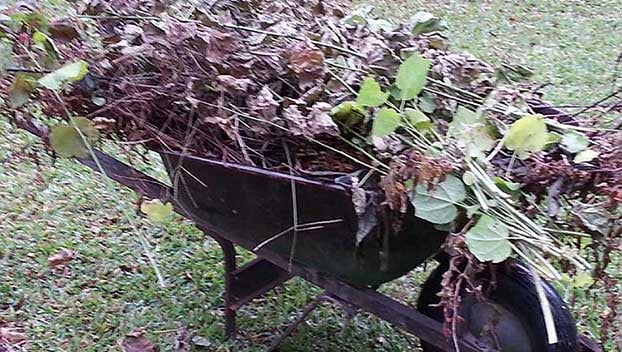MASTER GARDENER — See why February is time to spruce up the garden
Published 12:06 am Wednesday, February 1, 2023

- A wheelbarrow is a valuable gardening tool, providing countless uses from moving bagged fertilizer, potting down soil and mulch, holding lawn and garden debris, pruning plants and raking the lawn. (Courtesy of TAMU AgriLife)
|
Getting your Trinity Audio player ready...
|
Gardeners, spring is less than 50 days away with March 20 as the vernal equinox (Northern hemisphere), translating into equal intervals of daylight and night hours.
The number of daylight hours begin to lengthen while night time hours diminish, allowing us more time outdoors, doing things we enjoy most-gardening! Springs’ near, so to prepare for its arrival, start by catching up on gardening tasks (which if you’re like me) have progressed downward on your priorities list.
Most likely our final frost date will fall somewhere between the end of February through the middle of March, but if planting temperature sensitive plants early, be prepared by having frost cloth available to cover tender plants.
Maintenance-get prepared for springs’ “hustle” by ensuring garden tools and equipment are in good working order. Mower blades and pruning tools sharpened, rust removed from pruners, leaking garden hoses repaired, rust removed from pruners & sharpened, shovel/hoe handles sanded smooth & oiled, wheelbarrow tires holding air, etc. Perform necessary garden maintenance tasks now, before spring arrives, otherwise you will begin the season with an extended task list which is difficult to catch up on!
Pruning-perennials can be cut down to the ground with old wood removed because they regrow every year. When to prune really depends upon the type of plant. Spring blooming plants should be pruned after they bloom. There will also be times, though infrequent, where even a Texas native plant will need a bit of pruning, removing limbs near the ground or dead wood.
Vegetables-in Southeast Texas vegetable gardening begins in February, though not for sensitive plants like tomato or pepper which require warm soil and will be severely injured by a freeze. Transplant asparagus (crowns), broccoli, cauliflower, cabbage, collards, Brussel sprouts, Pak choi, potato (seed potatoes) and Tatsoi. Direct sow seeds for: beets, carrot, cool-season greens, daikon, green onion, lettuce, mustard, radish, spinach, Swiss chard, and turnip.
Trees, Fruits & Ornamentals-all potted perennials can be planted now. Summer and fall blooming perennial flowers such as daylilies, can be divided and transplanted in preparation for spring growth. Roses, shrubs, fruit trees, citrus, deciduous & evergreen trees can each be planted. Remember, most trees and shrubs require minimal pruning, or none whatsoever as pruning can be detrimental to the tree.
Begin fertilizing citrus trees, continuing through the end of September to early October. Typically, a nitrogen fertilizer is needed, this requirement can be satisfied organically by using compost or blood meal.
Prune roses with a goal in mind, they need an open, vase-like form to allow for improved air circulation and disease prevention, especially with our high humidity levels! Do Not prune spring-only blooming roses since buds will be removed! Antique roses which are repeat-bloomers need to be cut back about one-third their size and ‘Knockout’ roses can be pruned 1or 2 feet, as they grow rapidly. Train climbing rose canes, tying to supports for a tidy appearance.
Check fruit and nut trees, remove hanging bark “bags”, they are an indication of bagworms. If you planted strawberries (in October like me) there will be a few ripening with yields increasing. It might take them until March depending on the weather but continue watering and weeding them while keeping an eye out for pests like snails and slugs!
Ornamental Grass-some grasses like Pampas grass, can be sheared at this time but refrain from using shearing on natives’ grasses such as Mexican Feathergrass, Sideoats Grama, Lindheimer or Muhly, they prefer “fluffing” to remove dead material. Wearing heavy leather gloves, rake your hands upwards, fingers open to remove dead material within the plant. There are other methods of removing dead material which simulate a prairie grassland environment, I don’t recommend or encourage them due to inherent risks associated with fire.
Lawn Maintenance-it is too early so do not fertilize yet, wait until mid-April. Please don’t waste your hard-earned money purchasing “weed-and-feed” products as they simply don’t work very well. The best thing you can do for your lawn is have a soil analysis performed and determine exactly if any supplements are needed and the amount. Contact your county extension office for soil analysis assistance. Remember, pollution from over-fertilization and herbicides poses serious environmental consequences to conserving our rivers and groundwater.
To reiterate a point from a couple weeks ago regarding Crepe myrtles: Please don’t be an offender and commit crepe murder! Hacking off your tree isn’t going to increase the quantity of blooms and the weak, 1-year old wood cannot withstand the weight of its own flowers. The only pruning necessary is to remove diseased or dead wood, or suckers growing from the trees base. Remember the trees natural growth habit is vase shaped.
Mark your calendars: the Orange County Master Gardeners Spring Plant sale is March 18 at Jewel Cormier Park between 8am -1pm. There will be 25+ citrus tree varieties, fruit trees, berry plants, perennials, annuals, hanging baskets, shrubs, ferns, succulents, and more.
John Green is a Certified Texas Master Gardener. If you have gardening questions or need more information, contact the Orange County Master Gardeners Helpline at 409-882-7010 or visit txmg.org/orange, Orange County Texas Master Gardeners Association on Facebook or email extension@co.orange.tx.us.





